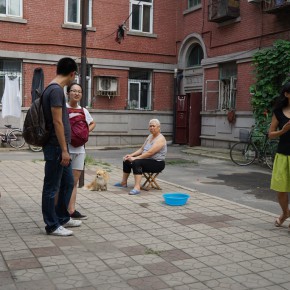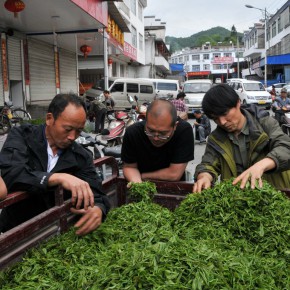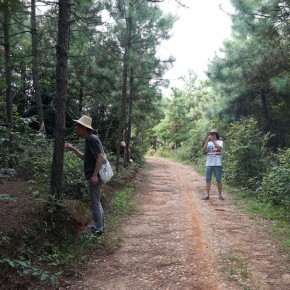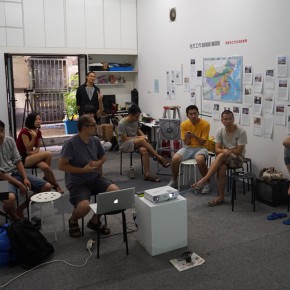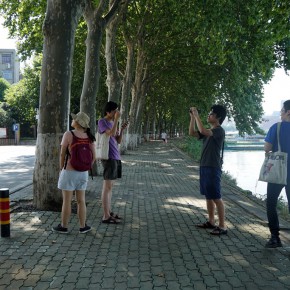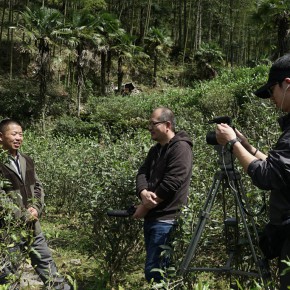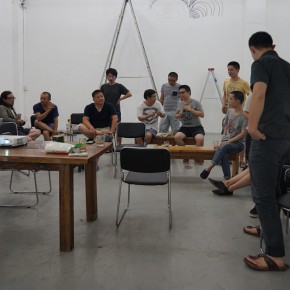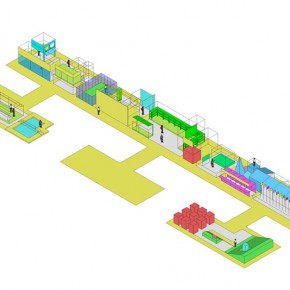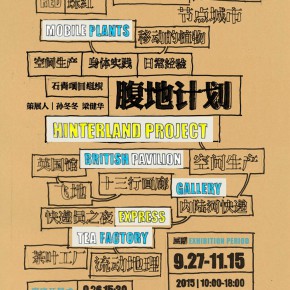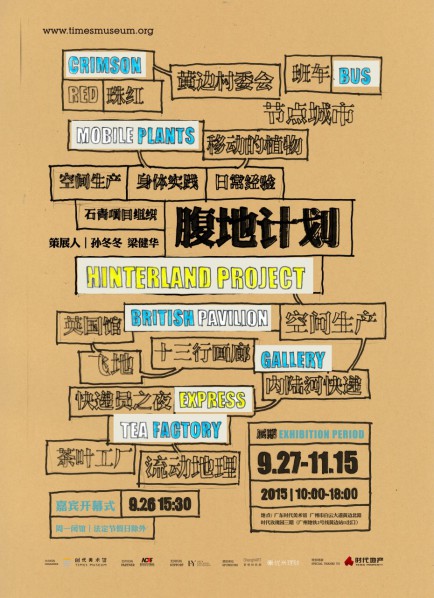
Our contemporary experience is being divided into new temporal points by an endlessly connected series of events that are interlocked and interactive. We are aware of changes in the world, but in our experience, these events are suspended in a temporary account—we mark off events as being “post-” to chart the beginning of a new narrative, and to constantly correct certain predictions we have had about the future. Just as globalization was ever the future that we longed for, and it has stopped being the ideal world we once conceived: on the macroscopic level, this is a world marked by increasingly intense economic inequalities and geo-political conflicts; on the microscopic level, our subjectivities are waiting to be redefined. The Hinterland Project takes the different stages of art production as subject of observation and practice. On one hand, the process of globalization of the Chinese contemporary art system has eroded the commonality that once existed between individuals—this erosion can be perceived from the conceptual dissent between work and action, as well as in internal ideological struggles. On the other hand, the symptoms of globalized production revealed that the art system is a transferrable globalization experience through which the fragmented world can be mediated into a kind of common experience.
The Hinterland Project differs from most museum solo exhibitions. It is a collective of nearly ten projects emerged from the artist Shi Qing’s curatorial practice and his collaboration with other artists. “Hinterland” draws from a geographic term, which implies the interlocutory relationship between globalization and localness. In the Hinterland Project, projects such as Bus Line and Interior River Courier Service will be carried out in seven hub cities across China, together with the other projects that are presented within the exhibition space, will form a logical structure represents the existing mechanisms of art: from exhibitions to residences, from the commercial galleries to the public art institution, which are all mixing together in practice. The Hinterland Project sets itself within a complex, polygonal and interweaving geographic network and aims at reenact the possibility of contemporary art production in China. British Pavilion is an unfinished rehearsal of global menus; Night of the Courier focuses on the everyday space of the world factory; Tea Factory attempts to establish dialogue in work. Space as deviation, as connecting point, as production relationship can serve as the live scene of social production and reproduction, and act as agency for subjectification. Therefore, the Hinterland Project is not a proposal of social intervention, but an act of inducting society into art. It is an attempt to create the moments of commonality within a temporary public field.Introductions to the project
Bus Line / Night of the Courier / British Pavilion / Tea Factory / Mobile Plants / Crimson / Huangbian Village Council / 13 Hong Gallery / Interior River Courier Service Bus LineThe Bus Line subproject expands the artistic field and vision from the core contemporary art cities to the areas of the hinterland, while attempting equalize their respective positions. This project has chosen Chongqing, Wuhan, Shenyang, Beijing, Shanghai, Guangzhou and Yueyang as its hub cities, with artists in each city serving as “couriers” to carry out practices on-site or mobile. “Bus line” emphasizes the artistic turn from the production of objects to the production of relational mechanisms, and towards today’s spatial production according to influence and integration of social production. Space is a means of capital operations, as well as a means of resistance. This project encourages artists to use everyday bodily practices and eventual methods to interrupt and interfere with the ossified production relationships while merging individual actions into the locality to form a site.
Number of couriers: 16
Chongqing: Liu Weiwei, Yu Guo, Wang Haichuan
Wuhan: Zi Jie
Shenyang: Pan He, Zhao Ze
Beijing: Guo Juan, Song Yi, Zeng Hong
Shanghai: Huang Songhao, Tang Chao, Pei En, Yao Mengxi
Guangzhou: Lin Aojie, Zhu Jianlin
Yueyang: Mao Zhenyu
Night of the Courier Night of the Courier takes on the role of a “residency program” in the Hinterland Project. It comprises two parts, the first part about the everyday life of the new workers will be realized in Dongguan.Guangdong Province as the world factory is the result of global capital movement and transfer to the Third World. It is also where the most heated conflicts between labor and capital happens. The gathering and formation of the new workers has coalesced into a new sociopolitical community. At a time when global labor movements are on low ebb, the political movements of Dongguan workers have attracted much attention.
Most of the workers in Dongguan come from the countryside, and lack the class awareness and organizational methods of traditional workers. They tend to form groups according to regional background and cultural affinity. In the project Dialects of the World Factory, artists will engage in research and practice in the Henan, Hunan and Guangxi settlements through the perspective of regional origin and language. Worker’s Dormitory researches the new collective spaces of workers, embodying capitalist strategies of disintegration and control of workers, as well as the absence of new forms of labor unions. The expression of and struggle for workers’ rights requires a new organizational method, and the public field is a formative space that gathers and forms certain new relationships. Social aesthetics are always inextricably linked to ideology and mass consumption. Dongguan is located in Guangdong Province, close to Shenzhen and Hong Kong, and is heavily influenced by mass consumer culture. In Wash-Cut-Blow—Dongguan Youth Aesthetics, hair salons and hairstyle rituals are a lens for observing and analyzing the aesthetics of new workers from a cultural perspective.
The second part of this project will be carried out in the museum. Drawing from Jacques Rancière’s concept of Nights of Labor, the artists will take the place of workers, reading theoretical compositions by night, and carrying out artistic creation in the museum by day, treating the exhibition space as a factory as they continue their social and artistic labor.
Like the Bus Line project, the artist-couriers carry out their work according to individual experience and in temporary small groups, and engage in discussion on-site. These are not anthropological methods but observation and interaction with the current world. Worker politics has never been just worker politics. It has always reflected the social contradictions, which are also the subject of artistic practice and observations. Today, artists ponder how to enter into social production relationships rather than serving as links in the chain of consumption and production. The artist-couriers are linked together through the Bus Line, Night of the Courier and Interior River Courier Service projects, becoming the main practioners of the Hinterland Project.
Participants: Huang Songhao, Liu Ya, Tang Chao, Zi Jie, Pei En, Liu Weiwei, Yu Guo
Dongguan Project: Everyday Life of the New Worker
a. Dialects: the World Factory Tower of Babel-Regional Affinity in Politics and Everyday Life
Xiaobian Village and Henan Village: Huang Songhao, Liu Ya
Shapu Village and You County, Hunan: Tang Chao
Jinsha Old Village, Sichuan Village: Yu Guo
Guangxi Express: Zi Jie
b. Worker’s Dormitory-Political Camps for New Workers: Liu Weiwei
c. Wash-Cut-Blow—Dongguan Youth Aesthetics: Pei En
British Pavilion British Pavilion is an interior segment of the Hinterland Project. This project responds to the concept of national pavilions within the mechanisms of contemporary art. It also relates to another subproject, Tea Factory.The Sino-British tea trade was an important component of early globalized trade. As a hub for tea trade, Guangzhou was of central geographic and cultural-economic importance. The British Pavilion has been placed in a standalone exhibition hall, spatially resembling an enclave or foreign concession. The glass house and plants (including tea trees) echo the exoticism and colonial splendor of tropical plants at the expos of old. This model later became the basis for museums and art expos.
During the exhibition, Shi Qing will arrange for museum volunteers to regularly perform the theater piece Proletarian Menu in the British Pavilion. With tea on the menu for British workers, and “diligent revolution” as a thread, this performance responds to the consumption of food for bodily energy and ideology in today’s globalized production, while presenting the connections between food and the production life among today’s new workers.
There is no script for this performance. There will be eight to ten performers, but that number can also change. Each rehearsal begins with an investigation, with volunteer groups sharing their observations and individual experiences. Performance methods will be used to convey the relations between the individual and globalizaiton. It is a perpetual rehearsal through analyzing of events.
Participants:
8-10 volunteers
Tea Factory
The Tea Factory project is also split into two components, Tea Factory I and Tea Factory II. Part I is a cinematic text about tea production that overlaps and compares contemporary art production with the tea production of the time.Though we are part of the globalized production and are taking part in the production and export of raw materials, we are still excluded from the relationships of production. Like the tea trade, contemporary art production is suspended and built over the local context. This cinematic composition, in imitation of the documentary film language, sifts through and rereads the paths of tea production as a reference for the art production of the day.
Tea Factory II is a framework and experiment in social theater. During the filming process, we travel deep into the hinterland of tea production, proposing the concept of inner cyclical paths. We also hope to once again link such relationships to the contours of today’s society, in order to catalyze a logical connection between the production of the two.During the exhibition, we will invite people from different walks of life to come and package these tea leaves to establish dialogue through production. The topics will be raised and hosted by the practicing artists.
Participants:
People from different classes and communities in Guangzhou, such as Times Rose Garden residents, students, transplants, Africans and workers.
Artist hosts:
Mao Zhenyu, Zi Jie, Liu Weiwei, Yu Guo, Song Yi, Yao Mengxi, Huang Songhao, as individuals or as groups
Mobile PlantsPlants are often symbols for passivity, silence, things that have been defined. In this sense, plants seem to be contradictory to such ideas as mobility and dialogue. But at the same time, plants are seen as carriers for locality and emotion.
Mobile Plants is in essence a dialogical project. It attempts to construct a dialogue within certain everyday circumstances, moving around within an everyday exercise space. The map of the body is outlined in everyday practice.
This project will invite Guangzhou transit system passengers to set out from the museum, and ride any form of public transportation, bringing a potted plant along for the ride, engaging in discussions about the Guangzhou geography they encounter along the way. The themes are related to individual experience, rather than knowledge. Public transit is a mobile collective group formed out of strangers. Speaking within this system can create a temporary dialogue space, and geographic topics are dual descriptions of memory and experience.
CrimsonThis is a dialogue plan consisting of secret meetings. The content and times of these discussions will not be announced in advance. The audience can watch surveillance videos of these meetings, but will not be able to hear any sound. There will be no audio recordings at the scene of the meetings, and only some of the content will be documented. The dialogue will mainly touch on Guangzhou’s revolutionary history, radical art and worker politics.
It may also be mixed in with news of aliens or anedotes about particular people. For artists, these are no different from political leanings or art criticism. The secret meetings of this project are not about the unknowable nature of their content, but on avoiding moralizing in the discussions, as well as exclusive tests or interference.
As the mechanisms for dialogue have grown increasingly weak, the dialogue itself has become a form ideology and political correctness. Crimson is like a psychological darkroom where psychoanalysis and treatment are exercised by both parties of the dialogue.
Huangbian Village Council
The art museum may be located in Huangbian Village, but the cultural projects here seem to form a rift with their surroundings. This project attempts to mobilized artists to engage in investigation and practice in Huangbian Village and to reveal or reactivate this relationship. This project overlaps with that of the artist-couriers. The practical process will inevitably be revised and rearranged, and the overall framework might be subverted. Thus, this is a platform for self-criticism and self-organization. Artists can engage with their own work and initiate their own dialogues.
13 Hong GalleryIn the late Qing dynasty, as international trade grew, a new product emerged: export painting. These were mainly souvenirs for foreigners. At first, most of them were painted by foreign painters, but gradually, Chinese painters began to take over. These export paintings often depicted commercial ports and buildings such as foreign commercial houses (known as Hongs) and diplomatic compounds, but some also depicted scenes of labor and life in China. Either consciously or unconsciously, they made these paintings through the eyes of foreigners.
The 13 Hong Gallery is designed according to the layout of a tennis court. It organizes artists from the hub cities to depict the colonial or foreign architecture in their cities. The project provides an opposite vision compared with the aforementioned perspective: the artists are to paint according to their own working logic or style, with the dimensions and mediums chosen by the artists themselves. The project promotes subjective work, as opposed to the gaze or perspective of the others in export paintings. These gazes of others are omnipresent in contemporary art, and even with the premise of this project, it cannot be completely turned around. Thus, the Hinterland Project is actually a constructive vision, gaining the possibility of a shared gaze in the return to self-context generation and the establishment of artistic self-awareness.Participants:
Beijing: Cai Zebin, He Xun, Zeng Hong
Chongqing: Yu Guo, Wang Haichuan, Li Yong
Wuhan: Gong Jian
Shanghai: Shi Zhiying
Shenyang: Song Yuanyuan, Geng Yinyi, Zhang Wuyun
Guangzhou: Tang Dayao, Huang Zhoutuo, Lin Aojie
Interior River Courier Service Interior River Courier Service serves to link the disparate parts of the Hinterland Project. It joins with Bus Line and Night of the Courier to create a fluid path. Like a logistics company, it also consists of two components, flow and storage. In the Bus Line project, the “interior river” cardboard boxes are themselves tools for shipping or creation, as well as a medium for fluidity. The boxes will be printed with promotional texts, slogans or posters regarding the various projects in each city.In the museum, the Interior River Courier Service will serve as a transfer center, the cardboard boxes and pushcarts as props for a moving exhibition, as well as a component open to viewer participation. This is a space for spontaneous activity where viewers can create texts and prints. These cardboard boxes become props linking together the various spaces. They are at once architectural materials and promotional items, barricades and vessels. Together with the viewers, they will appear in every corner of the scene.
About the project
Artist: Shi Qing
Curator: Sun Dongdong, Liang Jianhua
Preview: 15:30, Saturday, September 26, 2015 (Digital invitation only)
Exhibition Period: September 27 to November 15, 2015
Ticket Price: 20RMB per person (50% discount for students and groups)
Address: Times Rose Garden III, Huangbianbei Road, Baiyun Avenue, Guangzhou
Opening Hours: Tuesday – Sunday, 10 am – 6 pm (Closed on Monday except for holidays)
Guided Tour: 3:00-3:30 pm, September 27 – November 14, 2015, every Saturday & Sunday
Tel: +8620 26272363
Organizer: Guangdong Times Museum
Partners: Shanghart Gallery, New Century Art Foundation, F.Yang art & education foundation, Youmi Finance
Courtesy of the artist and Guangdong Times Museum, for further information please visit www.timesmuseum.org.


